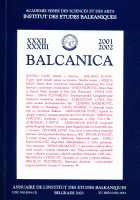Neke srpske paralele istočnoslovenskom Viju
Some Serbian Parallels to the East-Slavic Vij
Author(s): Aleksandar LomaSubject(s): Language and Literature Studies
Published by: Balkanološki institut - Srpska akademija nauka i umetnosti
Keywords: Vij; archidaemon; East Slavic tradition;
Summary/Abstract: Vij is a kind of monster or rather an archidaemon, appearing in the finale of Gogol’s tale thus entitled. The recent folkloric research confirms that an analogous figure is rooted in the East Slavic tradition. In a story inspired, too, by the popular beliefs, the 19th century Serbian author Milovan Glišić introduces, under similar circumstances, a similar demoniac personage. The resemblance between the both stories consists in the hero spending the night alone in a haunted place and being exposed to more and more dangerous attacks of the evil force, which culminate in the appearance of a lame creature with deeply pending eyelids: in Gogol it is called Vij, in Glišić simply grdoba ‘monster’. In view of the fact that the young Glišić was largely influenced by Gogol, a pure imitation of the latter by the former can not be excluded; nevertheless, it seems more probable that in this particular point the Serbian story-writer is not slavishly imitating the great Russian, but rather following his example in using some traditional topic he knew from his own country, for in the folklore of this, north-western part of Serbia and of some other Serbian regions very close parallels to Glišić’s narrative are to be found, which match also its details disagreeing with the Gogol’s story. The main difference consists in Gogol’s hero being unwillingly closed in an empty church and finally put to death by taking the look at the monster, Vij, while Glišić’s hero spends the night on a bridge voluntarily subjecting himself to the demonic temptation, in order to find a cure of a disease provoked by diabolic charms. Such a healing procedure is more than a folk tale motif; as late as the first half of the 20th century it was practised in Serbian Banat, where the patient (mostly a mentally handicapped child) used to be let to spend the night alone on the so-called Devil’s bridge (Ðavolji most) over Nera river and to expect the epiphany of the oldest devil, Daba (it was desirable to see only the top of Daba’s red cap emerging, and not his face). In a widespread Serbian superstition, Hromi („The Lame“) Daba is the king of devils, and there are some place names and local legends indicating that Glišić’s monster was originally identical with him. As for Ukrainian Vij, Abaev and some other scholars compared him with the Iranian Vayu, in regard both to his name and to his function of the doorkeeper in the kingdom of dead. The Serbian evidence corroborates this comparison by supplying the characteristic motif –lacking in the East-Slavic tradition– of a bridge between this and the other world; in the Zoroastrism, it is the „Good Vayu“, Vāi i vēh, who conducts the righteous souls of dead over the Činvat-bridge to the paradise, while his evil hypostasis Vāi i vattar prosecutes the impious ones...
Journal: BALCANICA
- Issue Year: 2001
- Issue No: 32+33
- Page Range: 123-143
- Page Count: 20
- Language: Serbian

